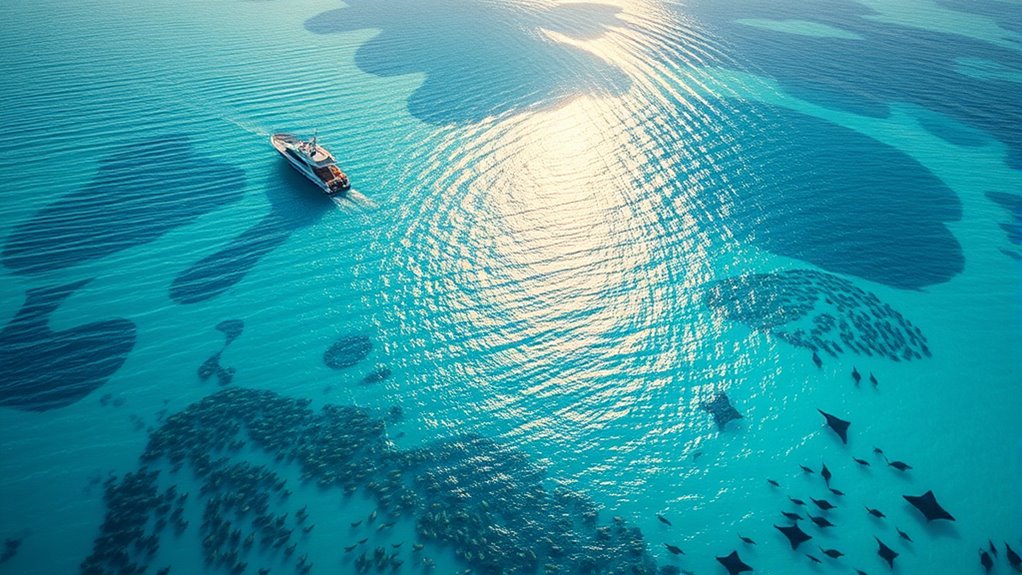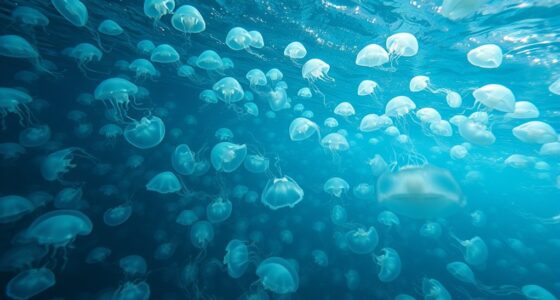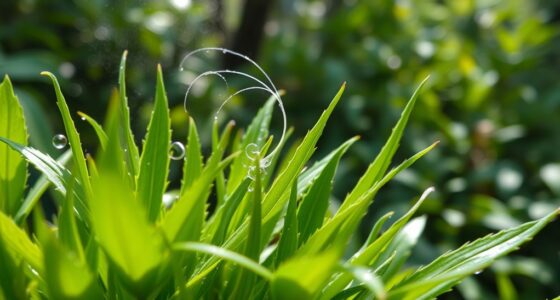A new, vast ocean sanctuary has been established to protect marine life and fragile ecosystems for future generations. This protected area aims to safeguard diverse species, restore coral reefs, and promote sustainable fishing. It also supports scientific research to reverse environmental damage and demonstrate a global commitment to ocean health. By creating this sanctuary, efforts are underway to guarantee thriving marine ecosystems. Continue exploring to discover how this initiative can impact ocean preservation worldwide.
Key Takeaways
- A new, expansive marine protected area has been established to safeguard diverse marine species and fragile ecosystems.
- The sanctuary emphasizes coral restoration using resilient species and innovative techniques to promote reef health.
- It enables effective ecosystem monitoring, sustainable fishing, and removal of invasive species for long-term conservation.
- The initiative demonstrates a global commitment to protecting ocean biodiversity and combating ecosystem decline.
- It highlights the economic and ecological benefits of healthy oceans, supporting future generations and global ocean resilience.

A new ocean sanctuary is being established to protect essential marine life and restore fragile ecosystems. This massive initiative marks a significant step forward in marine conservation, aiming to safeguard the diverse species that depend on these waters. This effort also highlights the importance of long-term sustainability to ensure that these protected areas remain effective for future generations. By creating this expansive protected area, you’re helping to guarantee that vital habitats, like coral reefs and breeding grounds, receive the attention and protection they deserve. The sanctuary will serve as a haven where marine animals can thrive without the constant threat of overfishing, pollution, or destructive human activities.
One of the key focuses within this sanctuary is coral restoration. Coral reefs are among the most vibrant and productive ecosystems on the planet, supporting countless species of fish, invertebrates, and other marine life. However, they face severe threats from climate change, ocean acidification, and destructive fishing practices. With this new sanctuary, you’re contributing to efforts that aim to repair and rebuild these delicate structures. Initiatives like coral planting, using resilient coral species, and developing innovative techniques to accelerate coral growth are now possible on a much larger scale. These efforts are essential because healthy coral reefs serve as the foundation of marine ecosystems, providing shelter, food, and breeding grounds for a multitude of marine creatures. Additionally, understanding the economic value of healthy oceans underscores the importance of conserving these ecosystems for global stability and prosperity.
As you look at this initiative, you’ll see that the sanctuary isn’t just about creating a safe space — it’s about actively restoring and maintaining the health of ocean environments. The protected zone allows marine conservationists to monitor ecosystems more effectively, implement sustainable fishing practices, and remove invasive species that threaten native populations. It also opens the door for scientific research, giving you a chance to witness firsthand how targeted conservation efforts can reverse damage and promote resilience in marine habitats. Additionally, establishing this sanctuary highlights the importance of cost and budgeting considerations to ensure the long-term success and sustainability of such large-scale environmental projects.
The establishment of this ocean sanctuary sends a clear message about the importance of protecting our planet’s oceans. You’re part of a global movement that recognizes the critical need to preserve marine biodiversity for future generations. Through these initiatives, you’re helping to combat the alarming decline of marine species and ecosystems. The hope is that, with continued effort and innovation, these protected waters will become vibrant, thriving ecosystems that support all forms of marine life, from tiny plankton to massive whales. This sanctuary isn’t just a haven for sea creatures — it’s a testament to what can be achieved when conservation and community efforts come together for the health of our oceans. marine biodiversity plays a crucial role in maintaining ocean health and resilience.
Frequently Asked Questions
How Will Enforcement Be Managed Across Such a Vast Area?
You might wonder how enforcement will work across such a vast area. Authorities plan to use a combination of marine patrols and enforcement drones to monitor activities continuously. These tools help detect illegal fishing or pollution quickly. You can trust that technology and dedicated patrols will work together to guarantee compliance, making enforcement more efficient and effective, even in the most remote parts of the sanctuary.
What Species Will Benefit Most From This Sanctuary?
You’ll see that many species will benefit most from this sanctuary, especially those crucial to marine biodiversity and species conservation. Large marine animals like whales, sharks, and sea turtles will gain protected habitats, reducing threats like fishing and pollution. Smaller, vulnerable species such as coral reefs and fish populations will also thrive, helping maintain ecological balance. Overall, this sanctuary supports the health of countless marine species, ensuring their survival for future generations.
How Does This Sanctuary Impact Local Fishing Communities?
Imagine a fisherman named Jose who’s seen fish populations dwindle. This sanctuary acts like a protected garden, helping fish thrive and replenishing stocks. It encourages sustainable fishing, ensuring you and other locals can fish responsibly without depleting resources. While some worry about short-term catches, in the long run, local economies benefit as healthier oceans support more abundant, sustainable fisheries, securing livelihoods for generations.
What Technology Is Used to Monitor Illegal Activities?
You’re likely curious about how illegal activities are monitored in protected areas. Authorities use advanced technology like satellite surveillance to track large-scale illegal fishing or pollution, providing real-time data from space. Drone monitoring complements this by offering close-up images and patrols, especially in remote or hard-to-reach zones. Together, these tools help enforce regulations effectively, ensuring marine life remains protected and illegal activities are swiftly identified and stopped.
Will There Be Public Access or Visitation Restrictions?
You might wonder if you’ll face tourism restrictions or visitation limits. Authorities aim to balance public access with conservation, so some areas may have restrictions to protect marine life. Community engagement is key here, ensuring local populations benefit and participate in preservation efforts. Expect designated zones for tourism and activities that promote awareness. Overall, restrictions are designed to preserve the sanctuary’s health while allowing responsible visitation, fostering sustainable tourism.
Conclusion
Imagine stepping into a vast, shimmering shield where countless marine creatures can thrive without fear. This new ocean sanctuary is your gift to the planet’s heartbeat, a mighty guardian in the deep blue. By protecting these waters, you’re nurturing a vibrant symphony of life, ensuring future generations can marvel at nature’s underwater wonderland. Together, you’ve opened a gateway to hope, where the ocean’s secrets can flourish, wild and free, beneath the endless waves.









